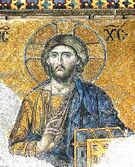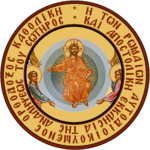Orthodox Christianity in micronationalism


Orthodox Christianity is a major branch of Christianity that traces its origins back to the early history of the religion. It includes both Eastern Orthodox Christianity and Oriental Orthodox Christianity. Among micronations, Orthodoxy is most commonly found in parts of the world where it its historical establishment is widespread, as well as in diaspora communities of Orthodox populations. Some micronations have national or state churches that are Orthodox, none of which have any recognized legitimacy beyond their own micronations, while others have citizens who are members in established Orthodox churches. This page lists all Orthodoxy-related activity in the micronational community.
Major micronational churches
Orthodox Church of Pavlov

The Orthodox Church of Pavlov is an independent sacramental movement in the Empire of Pavlov. Founded in 2014 by Metropolitan Cyril I and Emperor Alexander IV, it exercises jurisdiction over all Christians in the empire and includes one parish. Its see is located in the city of Aleksandropol, and its primate has been Filaret III, Ecumenical Patriarch since 30 December 2021, but its official head is the monarch of Pavlov. The church considered itself to be in union with the Catholic Church from 2014 to 2017, but now claims itself to be the sole legitimate Christian church. It is, however, unrecognized by the canonical Orthodox churches and may thus be considered an independent sacramental movement.
The church follows a Nicene Christian tradition and uses the Pavlovian language. It recognizes the Greek Old Testament, the New Testament, and the Quran as its scripture, the last of which it considers the final testament of Christian relevation. Like Nicene Christianity, it maintains a trinitarian theology, but it also recognizes Mary Magdalene, Muhammad, and Ali as apostles of the faith. For these reasons, the Orthodox Church of Pavlov may be considered by some part of the Islamic heterodox tradition called Alevism rather than part of Orthodox Christianity.
Roman Orthodox Church

The Roman Orthodox Church, also known as the Orthodox Church of Rhōmanía, is a canonically unrecognized Eastern Orthodox Church that is the state church of the Basileia of the Romans. It was founded on 15 September 2020 after it split from the autocephalous Church of Greece. The church includes one parish, the Church of the Ascension of the Saviour, but lacks any clergy. It exercises jurisdiction over the Roman co-capital city of New Constantinople. The church now considers itself to be an autonomous church of the Ecumenical Patriarchate of Constantinople and the successor to the Orthodox Church of Ashukovo.
The church follows an Eastern Orthodox tradition, in particular Greek Orthodox, and uses the Medieval and Koine forms of the Greek language. While it claims to be an autonomous church of the Ecumenical Patriarchate of Constantinople and so considers Bartholomew I of Constantinople to be its primate, it lacks recognition from the Ecumenical Patriarchate. Its caretaker is Emmanuel I & II, monarch of the nation, who was previously Patriarch of the Orthodox Church of Ashukovo. It is unrecognized by the canonical Orthodox churches. It can be considered an independent Orthodox movement within the Eastern Orthodox community.
Snagovian Orthodox Church

The Snagovian Orthodox Church is a canonically unrecognized Eastern Orthodox Church that is the state church of the Snagovian People's Republic. Founded in 2020 alongside the republic, it has 20 members and is headquartered in Silištea. The primate of the church is Daniel Avram, Patriarch of All Snagov. Its purview overlaps with that of the Romanian Orthodox Church in Snagov, as does its membership.
The church follows an Eastern Orthodox tradition and uses the Romanian, Snagovian, and Old Church Slavonic languages. It claims to trace its history to the arrival of Christianity to the region by Boris I of Bulgaria. The church is unrecognized by any canonical Orthodox churches, so it may be considered an independent Orthodox movement within the Eastern Orthodox community.
Other micronational churches
Minor churches
Minor churches:
- The Anglaviankian Orthodox Church — the largest church in Anglavianka.
- The Church of Cania — the state church of the Kingdom of Cania.
- The Church of Juclandia — the state church of the Juclandian Pragma.
- The Orthodox Autocephalous Church of Tarevia — a church in the Kingdom of Tarevia.
- The Orthodox Church of Eleftheria — the state church of the Imvrassian Province of Eleftheria.
- The Paloman Orthodox Church — a church in the Free Socialist State of Paloma.
Former churches
Former churches:
- The Digital Orthodox Church of Jerusalem was a church in the Kingdom of Jerusalem.
- The Nasriya Orthodox Church was the largest church in the Empire of Truto.
- The Orthodox Catholic Church of Begon was the state church of the Kingdom of Begon.
- The Orthodox Church of Ashukovo was the largest church in the Ashukov Federation.
- The Orthodox Church of Monmark was the state church of the Monmarkian Empire.
- The Orthodox Church of Plushunia was the largest church of Plushunia.
- The Ramarian Orthodox Church was a church in the Holy Kingdom of Ramaria.
- The Ykrainian Orthodox Church was the national church of the Republic of Ykrain.
Orthodoxy by country
Orthodox Christian micronations
Active micronations in which Orthodox Christianity is the official or co-official religion:
Active micronations in which Orthodox Christianity is not the official religion but is known to be largest single religion:
Statistics
Only active micronations with known data on its Orthodox Christian populations are listed in the table.
| Country | Total population | Orthodox population | % Orthodox |
|---|---|---|---|
| 133 | 91 | 68.4 | |
| 51 | 3 | 5.9 | |
| 55 | 55 | 100.0 |
Other active micronations with an Orthodox Christian presence include Anglavianka, Ashukovo, Athabasca, Austenasia, Baltia, the Brotherhood of the United Blocks, Byzantium Novum, Cania, Chayanbash, Constantia, Esgeldia, Ethosia, Grebna and Vonerebna, Imvrassia, Istria, Juclandia, Karnia-Ruthenia, Konakia, La Boca, Melite, Pavlov, Pinang, Radonia, Rhōmanía, Sabaria, Sitka, Spajistan, Tarevia, Teweria, Uhoriaszág, and Urabba Parks.
Orthodox people
- Aggelos I, emperor of Imvrassia
- Aikaterini, co-empress of Imvrassia
- Albert Henri Jinga, prime minister of Snagov
- Alcibiades I, monarch of Imperium Aquilae
- Alexander IV, former emperor of Pavlov
- Alin Valentin Kalibovič, Snagovian politician
- Arwelk I, tsar of Esgeldia
- Athanasios Pehlivanidis, former emperor of Serres
- Atyko Robijovych, prime minister of Athabasca
- Basil, Patriarch of the Anglaviankian Orthodox Church
- Bezborodov Korney Teryovich, former president of Sukhoyezhino
- Caesar Stamatios, prince of Imvrassia
- Christoph Billung, former tsar of Begon
- Ciprian of Juclandia, head of state of Juclandia
- Connie Sarah, former leader of Caelesta
- Constanța, queen of the Brotherhood of the United Blocks
- Cristian Dobrev, former president of Plushunia
- Damian Alexandru Gabriel, Luanian politician
- Danny Racovolis, monarch of Urabba Parks
- Despotissa Theologia, princess of Imvrassia
- Emmanuel I & II, monarch of Rhōmanía
- Filip Stanković, president of Anglavianka
- George d'Annenkov, former Chief Herald of Flandrensis
- George of Macedonia, former crown prince of Ovrestlia
- Henry Franklin, American micronationalist
- Ivan VII, emperor of Pavlov
- Jonathan I, emperor of Austenasia
- Krishna Kler, founder of Lathinie
- Maríe I, queen of Istria
- Marko Jadranko Arčidijakono, Snagovian politician
- Matthew Laptev, chancelor of Bepistan
- Mihail Aleksovič Mokanev, Snagovian politician
- Nada I, Grand Duchess of Marquette
- Nadia of Aysellant, Aysellantean politician
- Olivia Garcia, president of Spajistan
- Phillipe I, crown prince of Istria
- Quintus De Vitaliis, governor of Græcia
- Rareš Ivan Vasile, Snagovian politician
- Răzvan Juncu, king of Ranzania
- Roman I, tsar of Yakutia
- Stamatios, co-emperor of Imvrassia
- Stefan Oleksijovych Dobrovolskyj, former president of Ykrain
- Štefan Marius Snagoveanu, president of Snagov
- Thomas Marios I, emperor of Ovrestlia
- William, Prince of Granderia
- Winston I, king of Almoa
Place names of Orthodox origin
- Agionóros, Suverska (for Mount Athos)
See also
- Imperial University of Austenasia
- List of micronations by official religion
- Man in the Faith
- Microchurch
- Religion in micronationalism